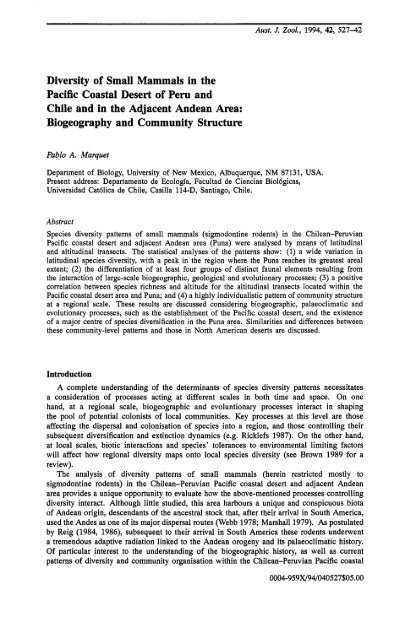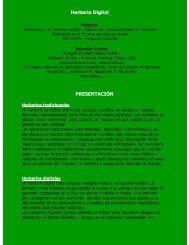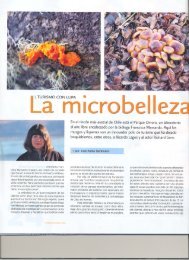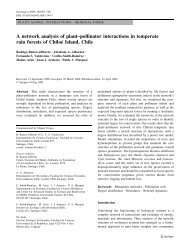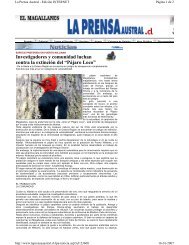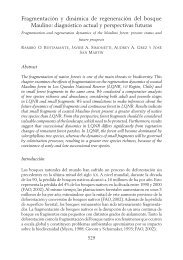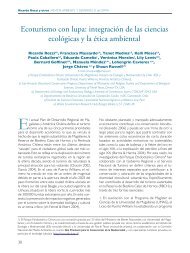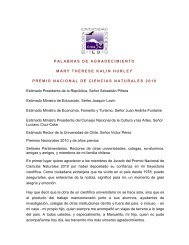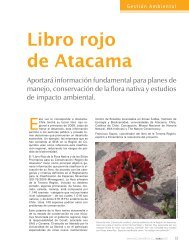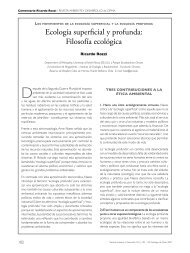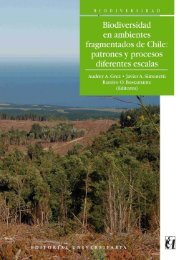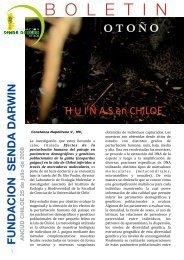Diversity of Small Mammals in the Pacific Coastal Desert of Peru ...
Diversity of Small Mammals in the Pacific Coastal Desert of Peru ...
Diversity of Small Mammals in the Pacific Coastal Desert of Peru ...
You also want an ePaper? Increase the reach of your titles
YUMPU automatically turns print PDFs into web optimized ePapers that Google loves.
Aust. J. Zool., 1994, 42, 527-42<strong>Diversity</strong> <strong>of</strong> <strong>Small</strong> <strong>Mammals</strong> <strong>in</strong> <strong>the</strong><strong>Pacific</strong> <strong>Coastal</strong> <strong>Desert</strong> <strong>of</strong> <strong>Peru</strong> andChile and <strong>in</strong> <strong>the</strong> Adjacent Andean Area:Biogeography and Community StructurePablo A. MarquetDepartment <strong>of</strong> Biology, University <strong>of</strong> New Mexico, Albuquerque, NM 87131, USA.Present address: Departamento de Ecologia, Facultad de Ciencias BioMgicas,Universidad Cat6lica de Chile, Casilla 114-D, Santiago, Chile.AbstractSpecies diversity patterns <strong>of</strong> small mammals (sigmodont<strong>in</strong>e rodents) <strong>in</strong> <strong>the</strong> Chilean-<strong>Peru</strong>vian<strong>Pacific</strong> coastal desert and adjacent Andean area (Puna) were analysed by means <strong>of</strong> latitud<strong>in</strong>aland altitud<strong>in</strong>al transects. The statistical analyses <strong>of</strong> <strong>the</strong> patterns show: (1) a wide variation <strong>in</strong>latitud<strong>in</strong>al species diversity, with a peak <strong>in</strong> <strong>the</strong> region where <strong>the</strong> Puna reaches its greatest arealextent; (2) <strong>the</strong> differentiation <strong>of</strong> at least four groups <strong>of</strong> dist<strong>in</strong>ct faunal elements result<strong>in</strong>g from<strong>the</strong> <strong>in</strong>teraction <strong>of</strong> large-scale biogeographic, geological and evolutionary processes; (3) a positivecorrelation between species richness and altitude for <strong>the</strong> altitud<strong>in</strong>al transects located with<strong>in</strong> <strong>the</strong><strong>Pacific</strong> coastal desert area and Puna; and (4) a highly <strong>in</strong>dividualistic pattern <strong>of</strong> community structureat a regional scale. These results are discussed consider<strong>in</strong>g biogeographic, palaeoclimatic andevolutionary processes, such as <strong>the</strong> establishment <strong>of</strong> <strong>the</strong> <strong>Pacific</strong> coastal desert, and <strong>the</strong> existence<strong>of</strong> a major centre <strong>of</strong> species diversification <strong>in</strong> <strong>the</strong> Puna area. Similarities and differences between<strong>the</strong>se community-level patterns and those <strong>in</strong> North American deserts are discussed.IntroductionA complete understand<strong>in</strong>g <strong>of</strong> <strong>the</strong> determ<strong>in</strong>ants <strong>of</strong> species diversity patterns necessitatesa consideration <strong>of</strong> processes act<strong>in</strong>g at different scales <strong>in</strong> both time and space. On onehand, at a regional scale, biogeographic and evoluntionary processes <strong>in</strong>teract <strong>in</strong> shap<strong>in</strong>g<strong>the</strong> pool <strong>of</strong> potential colonists <strong>of</strong> local communities. Key processes at this level are thoseaffect<strong>in</strong>g <strong>the</strong> dispersal and colonisation <strong>of</strong> species <strong>in</strong>to a region, and those controll<strong>in</strong>g <strong>the</strong>irsubsequent diversification and ext<strong>in</strong>ction dynamics (e.g. Ricklefs 1987). On <strong>the</strong> o<strong>the</strong>r hand,at local scales, biotic <strong>in</strong>teractions and species' tolerances to environmental limit<strong>in</strong>g factorswill affect how regional diversity maps onto local species diversity (see Brown 1989 for areview).The analysis <strong>of</strong> diversity patterns <strong>of</strong> small mammals (here<strong>in</strong> restricted mostly tosigmodont<strong>in</strong>e rodents) <strong>in</strong> <strong>the</strong> Chilean-<strong>Peru</strong>vian <strong>Pacific</strong> coastal desert and adjacent Andeanarea provides a unique opportunity to evaluate how <strong>the</strong> above-mentioned processes controll<strong>in</strong>gdiversity <strong>in</strong>teract. Although little studied, this area harbours a unique and conspicuous biota<strong>of</strong> Andean orig<strong>in</strong>, descendants <strong>of</strong> <strong>the</strong> ancestral stock that, after <strong>the</strong>ir arrival <strong>in</strong> South America,used <strong>the</strong> Andes as one <strong>of</strong> its major dispersal routes (Webb 1978; Marshall 1979). As postulatedby Reig (1984, 1986), subsequent to <strong>the</strong>ir arrival <strong>in</strong> South America <strong>the</strong>se rodents underwenta tremendous adaptive radiation l<strong>in</strong>ked to <strong>the</strong> Andean orogeny and its palaeoclimatic history.Of particular <strong>in</strong>terest to <strong>the</strong> understand<strong>in</strong>g <strong>of</strong> <strong>the</strong> biogeographic history, as well as currentpatterns <strong>of</strong> diversity and community organisation with<strong>in</strong> <strong>the</strong> Chilean-<strong>Peru</strong>vian <strong>Pacific</strong> coastal
P. A. MarquetFig. 1. Study area, located <strong>in</strong> <strong>the</strong> central Andes <strong>of</strong> South America. The shaded area represents<strong>the</strong> Puna; <strong>the</strong> lowland coastal area between about 59nd 279 is <strong>the</strong> Chilean-<strong>Peru</strong>vian <strong>Pacific</strong>coastal desert (modified from Vuilleumier and Simberl<strong>of</strong>f 1980).
<strong>Diversity</strong> <strong>of</strong> <strong>Small</strong> <strong>Mammals</strong> <strong>in</strong> a <strong>Coastal</strong> <strong>Desert</strong>desert, is <strong>the</strong> postulated existence <strong>of</strong> a centre <strong>of</strong> biotic diversification <strong>in</strong> <strong>the</strong> Andean area(Puna) adjacent to that desert (Mueller 1973; Reig 1984). This high diversity <strong>in</strong> <strong>the</strong> Punahighlands, characteristic <strong>of</strong> almost all vertebrate groups as well as <strong>of</strong> plants, is l<strong>in</strong>ked to<strong>the</strong> great opportunities for speciation provided by glacial advances, pluvial regimes, andlacustr<strong>in</strong>e stages that dom<strong>in</strong>ated <strong>the</strong> Andean Pleistocene at <strong>the</strong>se latitudes [see Ochsenius(1982) and Seltzer (1990) for reviews <strong>of</strong> <strong>the</strong> geological and climatic history].In this paper, I will present prelim<strong>in</strong>ary data on diversity patterns <strong>of</strong> small mammals<strong>in</strong> <strong>the</strong> Atacama desert and <strong>the</strong> adjacent Andean area, with special emphasis on <strong>the</strong> effect<strong>of</strong> biogeographic and evolutionary processes upon local community patterns. I will focuson two major questions: (1) whe<strong>the</strong>r <strong>the</strong>re is a pattern <strong>of</strong> altitud<strong>in</strong>al zonation <strong>in</strong> <strong>the</strong>assemblages <strong>of</strong> small mammals by latitude, and (2) whe<strong>the</strong>r <strong>the</strong>re is a pattern <strong>of</strong> assemblagestructure with regard to <strong>the</strong> number <strong>of</strong> locally coexist<strong>in</strong>g species and species comb<strong>in</strong>ationsacross local sites with<strong>in</strong> <strong>the</strong> area.Fig. 2. Altitud<strong>in</strong>al and latitud<strong>in</strong>al variation <strong>in</strong> mean annual ra<strong>in</strong>fall across <strong>the</strong> study area <strong>in</strong>nor<strong>the</strong>rn Chile.Material and MethodsStudy AreaThe Chilean-<strong>Peru</strong>vian <strong>Pacific</strong> coastal desert is located on <strong>the</strong> lowlands <strong>of</strong> <strong>the</strong> western slope<strong>of</strong> <strong>the</strong> Andes between latitudes 5" and 2TS, along <strong>the</strong> entire <strong>Peru</strong>vian coast and <strong>the</strong> nor<strong>the</strong>rn
P. A. MarquetIquique3Wv02kv4aFig. 3. The Atacama desert <strong>in</strong>nor<strong>the</strong>rn Chile. The thick l<strong>in</strong>erepresents <strong>the</strong> limit <strong>of</strong> <strong>the</strong> desertarea. Note <strong>the</strong> latitud<strong>in</strong>al <strong>in</strong>crease<strong>in</strong> <strong>the</strong> altitud<strong>in</strong>al limit <strong>of</strong> <strong>the</strong>Atacama desert (modified fromVillagrf<strong>in</strong> et al. 1983).part <strong>of</strong> Chile [Fig. 1; see also Villagr<strong>in</strong> et al. (1983), Rauh (1985) and Arroyo et al. (1988)for a general description <strong>of</strong> its limits]. Most authors divide <strong>the</strong> Chilean-<strong>Peru</strong>vian <strong>Pacific</strong> coastaldesert <strong>in</strong>to <strong>Peru</strong>vian coastal desert and Atacama (Chilean) coastal desert. Physiographically, thisregion is composed <strong>of</strong> three major units from west to east; <strong>the</strong> <strong>Coastal</strong> mounta<strong>in</strong> range, <strong>the</strong>Intermediate Depression, and <strong>the</strong> Andes mounta<strong>in</strong> range. Vegetation along <strong>the</strong> <strong>Coastal</strong> range isrestricted to <strong>the</strong> Lomas communities and <strong>the</strong> numerous dry valleys that dissect <strong>the</strong> landscapealong <strong>the</strong> east-west axis (see PCfaur 1982; Rauh 1985; Rundel et al. 1991). The IntermediateDepression, between latitudes 18" and 20°S, is characterised by <strong>the</strong> existence <strong>of</strong> forest patches<strong>of</strong> Prosopis tamarugo. Ra<strong>in</strong>fall steadily <strong>in</strong>creases on <strong>the</strong> <strong>Pacific</strong> slope <strong>of</strong> <strong>the</strong> Andes from lessthan 1 mm <strong>in</strong> <strong>the</strong> lowlands up to 400 mm <strong>in</strong> <strong>the</strong> Puna area (above 3800 m; Fig. 2). Whereas <strong>the</strong><strong>Pacific</strong> coastal desert is def<strong>in</strong>ed as a hot desert, <strong>the</strong> Puna area is a cold desert. The <strong>in</strong>crease <strong>in</strong>ra<strong>in</strong>fall with elevation is parallelled by changes <strong>in</strong> cover, physiognomy and dom<strong>in</strong>ant life formscharacteris<strong>in</strong>g plant communities. Accord<strong>in</strong>g to Villagr<strong>in</strong> et al. (1983) and Arroyo et al. (1988),
<strong>Diversity</strong> <strong>of</strong> <strong>Small</strong> <strong>Mammals</strong> <strong>in</strong> a <strong>Coastal</strong> <strong>Desert</strong>it is possible to def<strong>in</strong>e four major vegetational belts along <strong>the</strong> western slope <strong>of</strong> <strong>the</strong> Andes <strong>in</strong>nor<strong>the</strong>rn Chile: Prepuna, Puna, High-Andean and Subnival. The Puna area reaches its largestareal extent between latitudes 15" and 25"S, and narrows markedly towards nor<strong>the</strong>rn and sou<strong>the</strong>rnlatitudes (Fig. 1). The Atacama desert, on <strong>the</strong> o<strong>the</strong>r hand, <strong>in</strong>creases its altitudial penetrationtowards <strong>the</strong> south, from 1500 m at latitude 17"s up to 3000 m at latitudes 24-25"s (Fig. 3).Data and AnalysesThe database used <strong>in</strong> this paper is made up <strong>of</strong> 15 altitud<strong>in</strong>al transects, between latitudes 5"and 37"s. The transects were latitudes 5, 9, 12, 13, 15, 17, 18, 19, 22, 24, 30, 33, 35, 36and 37"s. I decided to <strong>in</strong>clude <strong>the</strong> latter five altitud<strong>in</strong>al transects, which lie well beyond <strong>the</strong>sou<strong>the</strong>rn boundary <strong>of</strong> <strong>the</strong> Atacama desert, to obta<strong>in</strong> a better picture <strong>of</strong> latitud<strong>in</strong>al species turnover,and to improve resolution <strong>of</strong> <strong>the</strong> dist<strong>in</strong>ctiveness <strong>of</strong> <strong>the</strong> <strong>Pacific</strong> desert and Puna small mammalfauna. Each transect was one latitud<strong>in</strong>al degree <strong>in</strong> width, and encompassed <strong>the</strong> area between <strong>the</strong>coast and <strong>the</strong> Puna. The presence and absence <strong>of</strong> species were recorded <strong>in</strong> each transect at fivealtitud<strong>in</strong>al belts spaced 1000 m from each o<strong>the</strong>r, from 0 m up to 5000 m. The source data wasretrieved from published studies (Mann 1945; Pearson 1951, 1982; K<strong>of</strong>ord 1954; Greer 1965;Dorst 1971; Meserve and Glanz 1978; Pearson and Ralph 1978; P<strong>in</strong>e et al. 1979; Pizzimenti andDeSalle 1981; Reise and Venegas 1987) and <strong>the</strong> author's unpublished data. Both univariate andmultivariate statistical methods were used to <strong>in</strong>vestigate patterns <strong>in</strong> this data set.In order to reveal additional trends with<strong>in</strong> <strong>the</strong> data, an ord<strong>in</strong>ation technique (Pr<strong>in</strong>cipalComponents Analysis; PCA) based on <strong>the</strong> covariance matrix was employed. The nature <strong>of</strong> <strong>the</strong>data (i.e. presence/absence) is likely to cause a 'horseshoe effect' (Williamson 1978), render<strong>in</strong>g<strong>in</strong>terpretation <strong>of</strong> <strong>the</strong> analysis difficult. In this study <strong>the</strong> considerable overlap <strong>in</strong> taxon compositionamong sample units has elim<strong>in</strong>ated this anomaly (see also Duigan and Kovach 1991). O<strong>the</strong>rexamples <strong>of</strong> <strong>the</strong> use <strong>of</strong> PCA as applied to <strong>in</strong>cidence data can be found <strong>in</strong> Jolliffe (1986) andKeller and Pitblado (1989). An additional analysis <strong>of</strong> clusters (not reported here) obta<strong>in</strong>ed with<strong>the</strong> UPGMA (Unpaired Group Mean Average) algorithm applied to a similarity matrix calculatedwith Jaccard's <strong>in</strong>dex, corroborated <strong>the</strong> pattern obta<strong>in</strong>ed by <strong>the</strong> PCA ord<strong>in</strong>ation technique.Results and DiscussionPalaeobiogeographyA key element to understand<strong>in</strong>g current patterns <strong>of</strong> diversity and distribution <strong>of</strong>sigmodont<strong>in</strong>e rodents <strong>in</strong> <strong>the</strong> coastal desert and adjacent Puna area is <strong>the</strong> history <strong>of</strong> arrivaland dispersal <strong>of</strong> <strong>the</strong>se rodents <strong>in</strong> South America, as well as <strong>the</strong> palaeoclimatic history <strong>of</strong><strong>the</strong> study area.The time at which sigmodont<strong>in</strong>e rodents entered South America and <strong>the</strong> pac<strong>in</strong>g <strong>of</strong><strong>the</strong>ir southward migration is a controversial issue. There are three major hypo<strong>the</strong>ses; oneadvocates <strong>the</strong> arrival <strong>of</strong> <strong>the</strong> ancestral stock dur<strong>in</strong>g <strong>the</strong> Late Pliocene, ano<strong>the</strong>r suggests atime <strong>of</strong> arrival by Early Miocene, and yet ano<strong>the</strong>r an Upper Miocene migration (see Webb1985 for a review). Marshall (1979) proposed a palaeobiogeographic model suggest<strong>in</strong>gthat sigmodont<strong>in</strong>e rodents arrived at South America by waif dispersal across <strong>the</strong> BolivarTrough dur<strong>in</strong>g a drop <strong>in</strong> sea level sometime between seven and five million years beforepresent. After this <strong>in</strong>itial dispersal event, <strong>in</strong> <strong>the</strong> Upper Miocene, <strong>the</strong>se rodents underwenta major adaptive radiation <strong>in</strong> <strong>the</strong> nor<strong>the</strong>rn Andean area. In a similar ve<strong>in</strong>, Reig (1986)identified <strong>the</strong> Puna area as <strong>the</strong> major centre <strong>of</strong> diversification <strong>of</strong> both phyllot<strong>in</strong>e andakodont<strong>in</strong>e rodents, supported by palaeoclimatic evidence and current patterns <strong>of</strong> diversityand endemism. This is <strong>in</strong> agreement with evidence presented by Vuilleumier and Simberl<strong>of</strong>f(1980) for Puna birds. As <strong>the</strong> issue stands, <strong>the</strong>re is no doubt that sigmodont<strong>in</strong>e rodentshad potential access to <strong>the</strong> Puna area and to <strong>the</strong> <strong>Pacific</strong> coastal desert throughout most <strong>of</strong><strong>the</strong> Pleistocene. Fur<strong>the</strong>r, <strong>the</strong> palaeoclimatic evidence and <strong>the</strong> current patterns <strong>of</strong> diversity,as po<strong>in</strong>ted out by Reig (1986) and Vuilleumier and Simberl<strong>of</strong>f (1980), characterise <strong>the</strong>Puna area as a major centre <strong>of</strong> diversification for both birds and sigmodont<strong>in</strong>e rodents.
P. A. MarquetIn <strong>the</strong> follow<strong>in</strong>g paragraphs I will briefly review <strong>the</strong> Pleistocene palaeoclimactic history <strong>of</strong><strong>the</strong> <strong>Pacific</strong> coastal desert (<strong>of</strong> <strong>the</strong> Atacama desert <strong>in</strong> particular) and Puna, <strong>in</strong> order to betterunderstand <strong>the</strong> orig<strong>in</strong> <strong>of</strong> <strong>the</strong>ir biota.The tim<strong>in</strong>g <strong>of</strong> orig<strong>in</strong> and subsequent climatic dynamics <strong>of</strong> <strong>the</strong> <strong>Pacific</strong> coastal desertis a controversial issue. On one hand, it has been proposed that arid conditions haveprevailed s<strong>in</strong>ce at least <strong>the</strong> Middle Miocene (Mortimer 1973; Mortimer and Saric 1975;Rundel et al. 1991 and references <strong>the</strong>re<strong>in</strong>). On <strong>the</strong> o<strong>the</strong>r hand, it is argued that hyperaridconditions are relatively recent <strong>in</strong> orig<strong>in</strong>, dat<strong>in</strong>g back to <strong>the</strong> Late Quaternary (Axelrod1979; Ochsenius 1982, 1985, 1986; Arroyo et al. 1988). Arroyo et al. (1988) provide anaccount <strong>of</strong> <strong>the</strong> historical development <strong>of</strong> aridity <strong>in</strong> <strong>the</strong> area on <strong>the</strong> basis <strong>of</strong> palaeobotanicaland geological data. These authors suggest that, dur<strong>in</strong>g <strong>the</strong> Miocene, <strong>in</strong> contrast to <strong>the</strong>present, <strong>the</strong> western side <strong>of</strong> <strong>the</strong> Andes was wetter than <strong>the</strong> eastern side, and propose <strong>the</strong>existence <strong>of</strong> a v<strong>in</strong>ey forest along <strong>the</strong> <strong>Pacific</strong> rim. Arroyo et al. (1988, p. 63) also proposethat, dur<strong>in</strong>g <strong>the</strong> Pliocene, <strong>the</strong>re occurred '... a gradual transition from <strong>the</strong> closed Mioceneforests <strong>in</strong>to more open, savanna-like vegetation at low elevations, with small, evergreentreelets develop<strong>in</strong>g at mid elevation'. These authors fur<strong>the</strong>r propose <strong>the</strong> existence, dur<strong>in</strong>g<strong>the</strong> Pleistocene, <strong>of</strong> xeromorphic vegetation and marked alternat<strong>in</strong>g wet and dry periods.Dur<strong>in</strong>g this time <strong>the</strong>re was an extensive development <strong>of</strong> forests <strong>of</strong> Prosopis tamarugo(Ochsenius 1982, 1986) support<strong>in</strong>g a rich assemblage <strong>of</strong> Pleistocene megafauna <strong>in</strong>clud<strong>in</strong>ggenera such as Mastodon, Macrauchenia, Equus, Mega<strong>the</strong>rium and Scelidodon. Most <strong>of</strong><strong>the</strong>se animals were present <strong>in</strong> <strong>the</strong> <strong>Pacific</strong> coastal desert area until <strong>the</strong> Late Pleistocene and<strong>the</strong> beg<strong>in</strong>n<strong>in</strong>g <strong>of</strong> <strong>the</strong> Holocene (Casamiquela 1969; Ochsenius 1982, 1985, 1986; Marshallet al. 1984). One po<strong>in</strong>t on which most authors agree, although with different emphasis [seeArroyo et al. (1988) and Rundel et al. (1991), and references <strong>the</strong>re<strong>in</strong>] is <strong>in</strong> <strong>the</strong> existence<strong>of</strong> more mesic conditions dur<strong>in</strong>g <strong>the</strong> Pleistocene. These mesic conditions, <strong>in</strong> addition to<strong>the</strong> existence <strong>of</strong> deeply cut, vegetated valleys that have traversed <strong>the</strong> current arid coastaldesert s<strong>in</strong>ce <strong>the</strong> Miocene (Mortimer 1980) and <strong>the</strong> extensive development <strong>of</strong> lacustr<strong>in</strong>eecosystems dur<strong>in</strong>g <strong>the</strong> Pleistocene stages M<strong>in</strong>ch<strong>in</strong> (28000 years before present) and Tauca(12500-11 000 years before present) (Servant and Fontes 1978; Hanstenrath and Kutzbach1985), provided <strong>the</strong> conditions for <strong>the</strong> colonisation <strong>of</strong> lowland areas by elements <strong>of</strong> Puneanflora and fauna (Ochsenius 1982, 1985, 1986; Arroyo et al. 1988; Marquet 1989; Meserveand Kelt 1990; Rundel et al. 1991; but see Caviedes and Iriarte 1989). The <strong>in</strong>crease <strong>in</strong>arid conditions dur<strong>in</strong>g <strong>the</strong> Late Pleistocene not only caused <strong>the</strong> ext<strong>in</strong>ction <strong>of</strong> megafaunalelements (Ochsenius 1982, 1985, 1986) but also <strong>of</strong> some species <strong>of</strong> small mammals. Thescenario that I propose entails three stages: (1) active diversification <strong>of</strong> phyllot<strong>in</strong>e andakodont<strong>in</strong>e rodents <strong>in</strong> <strong>the</strong> Puna area, (2) <strong>the</strong> subsequent dispersal and colonisation <strong>of</strong> some<strong>of</strong> those species <strong>in</strong>to <strong>the</strong> coastal desert dur<strong>in</strong>g Pleistocene times, and (3) <strong>the</strong> ext<strong>in</strong>ction <strong>of</strong>some forms dur<strong>in</strong>g <strong>the</strong> <strong>in</strong>creas<strong>in</strong>gly arid Holocene. In <strong>the</strong> follow<strong>in</strong>g sections I will focuson some contemporary biogeographic patterns affected by this sequence <strong>of</strong> diversification,colonisation and ext<strong>in</strong>ction ptocesses.BiogeographyLatitud<strong>in</strong>al patternsSpecies diversity <strong>of</strong> small mammals reaches a maximum <strong>of</strong> 18 species at latitude 17"sand decreases towards sou<strong>the</strong>rn and nor<strong>the</strong>rn latitudes (Fig. 4). However, <strong>the</strong> decl<strong>in</strong>e <strong>in</strong>diversity is steeper towards <strong>the</strong> south, where it drops to three species at latitude 24"S, thantowards <strong>the</strong> north (down to five species at latitude 5"s). This decrease on both sides <strong>of</strong><strong>the</strong> diversity peak co<strong>in</strong>cides with <strong>the</strong> concurrent decrease <strong>in</strong> areal extent <strong>of</strong> <strong>the</strong> Puna (seeFig. 1) and may be due to a pen<strong>in</strong>sular effect. Towards <strong>the</strong> south <strong>of</strong> <strong>the</strong> diversity peak,<strong>the</strong>re is <strong>the</strong> additional effect <strong>of</strong> <strong>the</strong> altitud<strong>in</strong>al penetration <strong>of</strong> <strong>the</strong> Atacama desert, almostcaus<strong>in</strong>g <strong>the</strong> disappearance <strong>of</strong> <strong>the</strong> Prepuna vegetational belt, and <strong>the</strong> shr<strong>in</strong>k<strong>in</strong>g <strong>of</strong> <strong>the</strong> Puna,High-Andean and Subnival belts (Villagr<strong>in</strong> et al. 1983).
<strong>Diversity</strong> <strong>of</strong> <strong>Small</strong> <strong>Mammals</strong> <strong>in</strong> a <strong>Coastal</strong> <strong>Desert</strong>10 5 10 15 20 25 30 36 40LATITUDE (degrees)Fig. 4. Latitud<strong>in</strong>al variation <strong>in</strong> species richness along <strong>the</strong> <strong>Pacific</strong> slope <strong>of</strong> <strong>the</strong> Andesbetween latitudes 5" and 37"s.-6 -4 -2 0 2 4 6 8PCA IFig. 5. Pr<strong>in</strong>cipal component analysis (PCA) <strong>of</strong> <strong>the</strong> 15 altitud<strong>in</strong>al transectsalong <strong>the</strong> <strong>Pacific</strong> coastal desert and Puna. The numbers <strong>in</strong>side <strong>the</strong> ellipsesidentify altitud<strong>in</strong>al transects by latitude.The PCA (Fig. 5) shows <strong>the</strong> existence <strong>of</strong> at least four different groups, based on <strong>the</strong>irsimilarity <strong>in</strong> species composition. Group I consists <strong>of</strong> species <strong>in</strong>habit<strong>in</strong>g <strong>the</strong> nor<strong>the</strong>rnmarg<strong>in</strong>al Puna area. The nor<strong>the</strong>rn limit <strong>of</strong> this group is set by <strong>the</strong> disappearance <strong>of</strong> <strong>the</strong>Puna area and by <strong>the</strong> appearance <strong>of</strong> <strong>the</strong> more mesic Paramo vegetation (Tosi 1960). Thesou<strong>the</strong>rn limit is set by <strong>the</strong> valley <strong>of</strong> <strong>the</strong> Acari river at latitude 14"s. As po<strong>in</strong>ted out byPearson (1982), this valley carves <strong>the</strong> landscape all <strong>the</strong> way from <strong>the</strong> coast to <strong>the</strong> Puna,act<strong>in</strong>g as a barrier to dispersal. The latitud<strong>in</strong>al transect at 5's occupies a more marg<strong>in</strong>alposition with<strong>in</strong> Group I. This is apparently a reflection <strong>of</strong> <strong>the</strong> low number and uniqueness<strong>of</strong> <strong>the</strong> species found at this latitude. Species such as Phyllotis gerbillus and Akodon mollisdo not occur <strong>in</strong> o<strong>the</strong>r transects along <strong>the</strong> <strong>Pacific</strong> slope <strong>of</strong> <strong>the</strong> Andes. The second group
534 P. A. Marquet<strong>of</strong> species is found <strong>in</strong> an area known as <strong>the</strong> arid Puna (Troll 1958). The nor<strong>the</strong>rn limit<strong>of</strong> Group I1 is also determ<strong>in</strong>ed by <strong>the</strong> Acari and Tambo rivers, which cause an arealbottleneck by cutt<strong>in</strong>g through <strong>the</strong> vegetational belts and stretch<strong>in</strong>g <strong>the</strong> Puna plateau. Inaddition, this limit co<strong>in</strong>cides with a latitud<strong>in</strong>al change <strong>in</strong> <strong>the</strong> floristic composition <strong>of</strong> plantcommunities (Tosi 1960). The sou<strong>the</strong>rn limit <strong>of</strong> Group I1 is associated with <strong>the</strong> pen<strong>in</strong>sulareffect produced by <strong>the</strong> narrow<strong>in</strong>g <strong>of</strong> <strong>the</strong> Puna, and with <strong>the</strong> altitud<strong>in</strong>al penetration <strong>of</strong><strong>the</strong> Atacama desert and consequent <strong>in</strong>crease <strong>in</strong> aridity and shr<strong>in</strong>k<strong>in</strong>g <strong>of</strong> vegetational belts(Villagrf<strong>in</strong> et al. 1983; Arroyo et al. 1988; Marquet 1989). The third group <strong>of</strong> speciesis found <strong>in</strong> an area called desert Puna (Troll 1958); Group I11 is characterised by <strong>the</strong>disappearance <strong>of</strong> species found <strong>in</strong> more nor<strong>the</strong>rly and sou<strong>the</strong>rly transects. This group <strong>of</strong>species is thus a depauperate subset <strong>of</strong> nor<strong>the</strong>rn and sou<strong>the</strong>rn faunal assemblages (onlythree species are present: Akodon olivaceus, Akodon and<strong>in</strong>us and Phyllotis darw<strong>in</strong>i). Thesou<strong>the</strong>rn limit <strong>of</strong> Group 111 is associated with <strong>the</strong> maximum altitud<strong>in</strong>al penetration <strong>of</strong> <strong>the</strong>Atacama desert (Fig. 3). The nor<strong>the</strong>rn limit is not clear. The fourth group <strong>of</strong> species isfound <strong>in</strong> a semidesert and mediterranean area that abuts <strong>the</strong> Atacama desert to <strong>the</strong> north.Also <strong>in</strong>cluded with<strong>in</strong> Group IV are those transects found <strong>in</strong> <strong>the</strong> area <strong>of</strong> <strong>the</strong> temperatedeciduous forests.Altitud<strong>in</strong>al patternsTable 1. Kendall's rank correlation coefficients between <strong>the</strong>number <strong>of</strong> species <strong>of</strong> small mammals and altitude, for 15transects at different latitudes along <strong>the</strong> <strong>Pacific</strong> slope <strong>of</strong> <strong>the</strong>Andesn.a., not applicable (see text); n.s., not significant; **, P < 0.05;***, P < 0.01Latitude Total no. r P<strong>of</strong> species5"s 5 0.0 n.s.9" S 9 0.95 ***12"s 9 0.95 ***13"s 9 1.00 ***15"s 13 1.00 ***17"s 18 0.95**t18"s 16 0.53 n.s.19"s 7 0.5322"s 5 0.89n.s.**n.s.30"s 6 -0.81 **24"s 3 -0.4133"s 8 -0.67 n.s.35"s 8 n.a. n.a.36"s 937"s 9n.a.n.a.n.a.n.a.The correlation analysis (Table 1) shows that, from latitude 9" to 22"S, correlationcoefficients are positive (i.e. species richness <strong>in</strong>creases with altitude). The transect at 5OShad a correlation coefficient <strong>of</strong> 0.0 because <strong>the</strong> same species were present <strong>in</strong> <strong>the</strong> threealtitudes available for analysis. The low altitude reached by <strong>the</strong> Andes at this latitudeprecluded <strong>the</strong> <strong>in</strong>clusion <strong>of</strong> additional altitud<strong>in</strong>al belts. At latitudes 24", 30" and 33"S, <strong>the</strong>sign <strong>of</strong> <strong>the</strong> correlation reversed. Transects 35", 36" and 37"s were not <strong>in</strong>cluded <strong>in</strong> <strong>the</strong>analysis because only two altitud<strong>in</strong>al belts were present, ow<strong>in</strong>g to <strong>the</strong> low altitude reachedby <strong>the</strong> Andes at <strong>the</strong>se latitudes. To fur<strong>the</strong>r explore this pattern, I performed correlationsbetween <strong>the</strong> total number <strong>of</strong> species <strong>of</strong> small mammals found at a given altitud<strong>in</strong>al transectand <strong>the</strong> number <strong>of</strong> species found present <strong>in</strong> each altitud<strong>in</strong>al belt. Only transects ly<strong>in</strong>g
<strong>Diversity</strong> <strong>of</strong> <strong>Small</strong> <strong>Mammals</strong> <strong>in</strong> a <strong>Coastal</strong> <strong>Desert</strong>with<strong>in</strong> <strong>the</strong> desert area were <strong>in</strong>cluded (i.e. 5-24"s). The results (Table 2) show that <strong>the</strong>number <strong>of</strong> species found <strong>in</strong> <strong>the</strong> altitud<strong>in</strong>al belts above 3000 m is positively correlatedwith <strong>the</strong> total number <strong>of</strong> species with access to a particular altitud<strong>in</strong>al transect. That is,an <strong>in</strong>crease <strong>in</strong> <strong>the</strong> number- <strong>of</strong> species <strong>in</strong> latitude only affect high-altitude environments;species tend to accumulate <strong>in</strong> <strong>the</strong> highlands. The factors affect<strong>in</strong>g species diversity behavedifferently below 3000 m. Regional diversity probably affects local diversity (see Ricklefs1987) only <strong>in</strong> those areas located above 3000 m, whereas below it <strong>the</strong> existence <strong>of</strong> <strong>the</strong>coastal desert imposes a serious barrier to <strong>the</strong> passive diffusion or spill-over <strong>of</strong> species fromareas <strong>of</strong> high diversity <strong>in</strong> <strong>the</strong> highlands. In this scenario it is not surpris<strong>in</strong>g that desertlowland species may have evolved physiological adaptations, such as hydric <strong>in</strong>dependenceand torpor (see K<strong>of</strong>ord 1968; Boz<strong>in</strong>ovic and Marquet 1991), to cope with one <strong>of</strong> <strong>the</strong>world's most arid deserts (Borgel 1973).Table 2. Kendall's rank correlation coefficients between <strong>the</strong>total number <strong>of</strong> species present at each altitud<strong>in</strong>al transectand <strong>the</strong> number <strong>of</strong> species found at each altitud<strong>in</strong>al beltn, number <strong>of</strong> observations; n.s., not significant; ***, P c 0.01Altitud<strong>in</strong>al belt (m) n r PIn general, <strong>the</strong>se results are consistent with previous studies (Pearson 1951, 1982;Spotorno 1976; Pearson and Ralph 1978; Pizzimenti and DeSalle 1981) that po<strong>in</strong>t out<strong>the</strong> existence <strong>of</strong> a positive correlation between species richness and altitude <strong>in</strong> <strong>the</strong> areabetween <strong>the</strong> <strong>Pacific</strong> coastal desert and <strong>the</strong> Puna. At this po<strong>in</strong>t it is <strong>in</strong>terest<strong>in</strong>g to notethat this f<strong>in</strong>d<strong>in</strong>g contradicts <strong>the</strong> rule <strong>of</strong> decreas<strong>in</strong>g number <strong>of</strong> species with <strong>in</strong>crease <strong>in</strong>altitude (e.g. Stevens 1992 and references <strong>the</strong>re<strong>in</strong>). A negative correlation between speciesrichness and altitude is likely to arise if most speciation events have occurred <strong>in</strong> lowlandhabitats. Therefore, species' primary adaptations are suited to lowland environments, andhighlands represent, to some extent, stressful habitats that are difficult to colonise and<strong>in</strong> which to persist. However, <strong>in</strong> <strong>the</strong> case <strong>of</strong> <strong>the</strong> <strong>Coastal</strong> desert-Puna axis, <strong>the</strong> oppositeoccurs. Here, most speciation events were associated with high-altitude environments, wherea major centre <strong>of</strong> species diversification was located. The primary adaptations <strong>of</strong> <strong>the</strong>sespecies were to cope with cold, high-altitude environments, and lowland habitats were <strong>of</strong>marg<strong>in</strong>al value. Hence <strong>the</strong> positive correlation between altitude and species richness. Asan alternative hypo<strong>the</strong>sis, it could be argued that <strong>the</strong> positive correlation emerges because<strong>of</strong> <strong>the</strong> existence <strong>of</strong> a lowland hyperarid desert that limits diversity <strong>in</strong> lowland areas tosuch low levels as to produce a pattern <strong>of</strong> positive correlation that would o<strong>the</strong>rwise benegative. Although I do not deny that <strong>the</strong> onset <strong>of</strong> arid conditions <strong>in</strong> <strong>the</strong> lowlands caused<strong>the</strong> ext<strong>in</strong>ction <strong>of</strong> some species (Marquet 1989), <strong>the</strong> historical effect <strong>of</strong> a high-altitude centre<strong>of</strong> diversification seems more pervasive. The key evidence <strong>in</strong> support <strong>of</strong> this hypo<strong>the</strong>sisis <strong>the</strong> existence <strong>of</strong> a positive correlation between species richness and altitude along <strong>the</strong>eastern side <strong>of</strong> <strong>the</strong> Andes Cordillera (Patton 1986; Cadle and Patton 1988; J. Salazar,T. Yates and P. Marquet, unpublished data), where Puna vegetation gives way to Yungasforest and lowland tropical ra<strong>in</strong>forest.As emphasised earlier, <strong>the</strong> existence <strong>of</strong> a high-altitude centre <strong>of</strong> biotic diversification hasaffected both latitud<strong>in</strong>al and altitud<strong>in</strong>al patterns <strong>of</strong> species diversity, leav<strong>in</strong>g strong signsbeh<strong>in</strong>d, such as a latitud<strong>in</strong>al peak <strong>in</strong> species richness (Fig. 4) and an 'anomalous' positivecorrelation between species richness and altitude. The onset <strong>of</strong> hyperarid conditions dur<strong>in</strong>g
P. A. Marquet<strong>the</strong> Late Pleistocene caused <strong>the</strong> ext<strong>in</strong>ction <strong>of</strong> some lowland species, fur<strong>the</strong>r contribut<strong>in</strong>g to<strong>the</strong>se altitud<strong>in</strong>al and latitud<strong>in</strong>al patterns <strong>of</strong> diversity, and also acted as a strong selectiveenvironment favour<strong>in</strong>g <strong>the</strong> evolution <strong>of</strong> desert-adapted physiological traits <strong>in</strong> those speciescurrently found with<strong>in</strong> <strong>the</strong> conf<strong>in</strong>es <strong>of</strong> <strong>the</strong> coastal desert.Community StructureIn light <strong>of</strong> <strong>the</strong> complex <strong>in</strong>teractions among dispersal, diversification, adaptation andext<strong>in</strong>ction processes that shaped patterns <strong>of</strong> species diversity <strong>in</strong> <strong>the</strong> coastal desert andadjacent Andean area, one is tempted to predict a highly <strong>in</strong>dividualistic pattern <strong>of</strong> communitystructure at a regional scale (see Graham 1986; Brown and Kurzius 1987). I have juststarted to address this question, follow<strong>in</strong>g <strong>the</strong> lead <strong>of</strong> Brown and Kurzius' work on patterns<strong>in</strong> species distribution and coexistence at a regional scale. From <strong>the</strong> analysis <strong>of</strong> 120sites distributed with<strong>in</strong> <strong>the</strong> Atacama <strong>Desert</strong> and Puna areas <strong>of</strong> <strong>Peru</strong>, Argent<strong>in</strong>a and Chile(Marquet, unpublished data), <strong>the</strong> follow<strong>in</strong>g patterns arise. First, most sites (80%) are<strong>in</strong>habited by 1-3 species (Fig. 6); this is significantly different from that expected froma random association <strong>of</strong> species with sites (i.e, under a Poisson distribution) (G = 41.8,d.f. = 12, P < 0.001). Second, when <strong>the</strong> number <strong>of</strong> different species comb<strong>in</strong>ationsis analysed (Fig. 7), a distribution similar to that found <strong>in</strong> Fig. 6 emerges. However,because sites with few species are more likely to have redundant comb<strong>in</strong>ations <strong>of</strong> species,<strong>the</strong> frequency distribution <strong>of</strong> different comb<strong>in</strong>ations observed peaks at three, ra<strong>the</strong>r thantwo, species. A G-test shows that <strong>the</strong> observed distribution is significantly different froma Poisson distribution (G = 76.44, d.f. = 12, P < 0.001). F<strong>in</strong>ally, with regard to <strong>the</strong>Number <strong>of</strong> speciesFig. 6. Frequency distribution <strong>of</strong> <strong>the</strong> number <strong>of</strong> coexist<strong>in</strong>g species among local sites. Thecurved l<strong>in</strong>e represents expectations under a Poisson distribution.
<strong>Diversity</strong> <strong>of</strong> <strong>Small</strong> <strong>Mammals</strong> <strong>in</strong> a <strong>Coastal</strong> <strong>Desert</strong>Number <strong>of</strong> species per siteFig. 7. The number <strong>of</strong> different comb<strong>in</strong>ations <strong>of</strong> different numbers <strong>of</strong> locally coexist<strong>in</strong>g species.The curved l<strong>in</strong>e represents expectations under a Poisson distribution.Number <strong>of</strong> times comb<strong>in</strong>ation observedN = 63 different comb<strong>in</strong>ationsFig. 8. The number <strong>of</strong> times that different comb<strong>in</strong>ations <strong>of</strong> locally coexist<strong>in</strong>g species wereobserved.
P. A. Marquetfrequency with which a particular comb<strong>in</strong>ation <strong>of</strong> coexist<strong>in</strong>g species occurred (Fig. 8), 63different comb<strong>in</strong>ations <strong>of</strong> species were observed, 75% <strong>of</strong> which occurred only once. Mostspecies occurred with many different comb<strong>in</strong>ations <strong>of</strong> o<strong>the</strong>r species. Six species occurred<strong>in</strong> more than 10 different comb<strong>in</strong>ations, and two occurred <strong>in</strong> more than 25 comb<strong>in</strong>ations.When <strong>the</strong>se patterns are compared with those described by Brown and Kurzius (1987)for North American deserts, some similarities can be detected. In both desert areas <strong>the</strong>frequency distribution <strong>of</strong> coexist<strong>in</strong>g species is right-skewed. However, <strong>the</strong> modal number<strong>of</strong> coexist<strong>in</strong>g species is two <strong>in</strong> <strong>the</strong> South American desert (Fig. 6) and three for that<strong>in</strong> North America. Similarly, most <strong>of</strong> <strong>the</strong> species coexist with a large array <strong>of</strong> differentspecies, form<strong>in</strong>g comb<strong>in</strong>ations that are generally unique. This <strong>in</strong>dividualistic pattern <strong>in</strong> <strong>the</strong>geographic structure <strong>of</strong> species assemblages may be characteristic not only <strong>of</strong> desert areasbut a more widespread feature <strong>of</strong> regional faunas, <strong>in</strong>dicat<strong>in</strong>g <strong>the</strong> complex <strong>in</strong>terplay betweenlarge-scale biogeographic and evolutionary processes, as well as local species <strong>in</strong>teractionand adaptation. These patterns do not conflict with <strong>the</strong> existence <strong>of</strong> determ<strong>in</strong>istic processesaffect<strong>in</strong>g community organisation at regional scales. As has been shown by Bowers andBrown (1982), species <strong>of</strong> similar body size coexist locally less frequently than expectedby chance. In addition, <strong>the</strong>re is a nested hierarchy underly<strong>in</strong>g patterns <strong>of</strong> species regionalcoexistence for North American desert rodents (Patterson and Brown 1991) as well asfunctional assembly rules underly<strong>in</strong>g <strong>the</strong> build-up <strong>of</strong> local communities (Fox and Brown1993). These types <strong>of</strong> analyses applied to <strong>the</strong> South American desert areas may contributeto a better understand<strong>in</strong>g <strong>of</strong> <strong>the</strong> regularities underly<strong>in</strong>g <strong>the</strong> geographic structure <strong>of</strong> speciesassemblages.Conclud<strong>in</strong>g RemarksMany <strong>of</strong> <strong>the</strong> relevant questions concern<strong>in</strong>g <strong>the</strong> structure <strong>of</strong> natural communities canbe fruitfully approached at <strong>the</strong> <strong>in</strong>terface between ecology and biogeography (e.g. Brown1984; Ricklefs 1987, 1989; Brown and Maurer 1989; Jackson and Harvey 1989; Lawton1990; Tonn et al. 1990; H<strong>in</strong>ch et al. 1991; Cornell and Lawton 1992; Ricklefs andSchluter 1993). The traditional approach <strong>of</strong> work<strong>in</strong>g on small spatial scales (see Kareivaand Anderson 1988; Pimm 1992) has been preferred <strong>in</strong> <strong>the</strong> past because at this scale itis possible to perform experiments. These manipulations have proven to be a powerfulway to test alternative hypo<strong>the</strong>ses and to identify important processes and mechansimsthat generate patterns <strong>of</strong> community structure (e.g. competition, predation). However, <strong>the</strong>reis much more to <strong>the</strong> structure <strong>of</strong> natural systems than can be learned by study<strong>in</strong>g <strong>the</strong>irphenomenology at small spatial scales. An <strong>in</strong>crease <strong>in</strong> <strong>the</strong> spatial scale <strong>of</strong> analysis beyond<strong>the</strong> local scale makes it possible to: (1) understand regional biogeographic patterns thatemerge as <strong>the</strong> result <strong>of</strong> local dynamics and species' tolerance to biotic and abiotic conditions(e.g. Diamond 1975; Hanski 1982; Moulton and Pimm 1983; Brown 1984, 1987; Brownand Maurer 1989; Roughgarden 1989; Brown and Nicoletto 1991); and (2) address newquestions about metapopulation dynamics and spatial variability <strong>in</strong> <strong>the</strong> structure <strong>of</strong> speciesassemblages (e.g. Hanski 1982; Brown 1984; Brown and Kurzius 1987, 1989; Gilp<strong>in</strong> andHanski 1991).As po<strong>in</strong>ted out by Graham (1986), Brown and Kurzius (1987), and this study, mostlocal communities are unique <strong>in</strong> terms <strong>of</strong> <strong>the</strong>ir species composition. This emphasises <strong>the</strong>need for caution <strong>in</strong> generalis<strong>in</strong>g about species <strong>in</strong>teractions from <strong>the</strong> analysis <strong>of</strong> one or afew sites with<strong>in</strong> a region.AcknowledgmentsI thank Luis Contreras, Douglas Kelt, Brian Lang and Sergio Silva for comment<strong>in</strong>gon different versions <strong>of</strong> this manuscript. Jim Brown and George Stevens provided helpfuldiscussion and <strong>in</strong>sights on <strong>the</strong> topics addressed <strong>in</strong> this paper. This work was supported
<strong>Diversity</strong> <strong>of</strong> <strong>Small</strong> <strong>Mammals</strong> <strong>in</strong> a <strong>Coastal</strong> <strong>Desert</strong>by FONDECYT 0585189, and partially by"WWF No. 7578, The American Society <strong>of</strong>Mammalogists, L<strong>in</strong>coln Park Scott Neotropical Fund, Sigma-Xi, and <strong>the</strong> Lat<strong>in</strong> AmericanInstitute (University <strong>of</strong> New Mexico).ReferencesArroyo, M. T. K., Squeo, E A., Armesto, J. J., and Villagrf<strong>in</strong>, C. (1988). Effects <strong>of</strong> aridity onplant diversity <strong>in</strong> <strong>the</strong> nor<strong>the</strong>rn Chilean Andes: results <strong>of</strong> a natural experiment. Annals <strong>of</strong> <strong>the</strong>Missouri Botanical Garden 75, 55-78.Axelrod, D. I. (1979). <strong>Desert</strong> vegetation, its age and orig<strong>in</strong>. In 'Arid Land Plant Resources'.(Eds J. R. Good<strong>in</strong> and D. K. Noth<strong>in</strong>gton.) pp. 1-72. (Texas Tech. University Press: Lubbock,Texas.)Borgel, 0. (1973). The coastal desert <strong>of</strong> Chile. In '<strong>Coastal</strong> <strong>Desert</strong>s'. (Eds D. H. K. Amiran and- A. W. Wilson.) pp. 11-21. (University <strong>of</strong> Arizona Press: Tucson, Arizona.)Bowers, M. A., and Brown, J. H. (1982). Body size and coexistence <strong>in</strong> desert rodents: chance orcommunity structure? Ecology 63, 391-400.Boz<strong>in</strong>ovic, F., and Marquet, P. A. (1991). Energetics and torpor <strong>in</strong> <strong>the</strong> Atacama desert-dwell<strong>in</strong>grodent Phyllotis darw<strong>in</strong>i rupestris. Journal <strong>of</strong> Mammalogy 72, 734-8.Brown, J. H. (1984). On <strong>the</strong> relationship between abundance and distribution <strong>of</strong> species. AmericanNaturalist 124, 255-79.Brown, J. H. (1987). Variation <strong>in</strong> desert rodent guilds: patterns processes and scales. In'Organization <strong>of</strong> Communities Past and Present'. (Eds J. H. R. Gee and P. S. Giller.)pp. 185-203. (Blackwell: Oxford.)Brown, J. H. (1989). Species diversity. In 'Analytical Biogeography'. (Eds A. A. Myers and P.S. Giller.) pp. 57-89. (Chapman and Hall: London.)Brown, J. H., and Kurzius, M. (1987). Composition <strong>of</strong> desert rodent faunas: comb<strong>in</strong>ations <strong>of</strong>coexist<strong>in</strong>g species. Annales Zoologici Fennici 24, 227-37.Brown, J. H., and Kurzius, M. A. (1989). Spatial and temporal variation <strong>in</strong> guilds <strong>of</strong> North Americangranivorous desert rodents. In 'Patterns <strong>in</strong> <strong>the</strong> Structure <strong>of</strong> Mammalian Communities'. SpecialPublications <strong>of</strong> <strong>the</strong> Texas Technical University Museum, No. 28. (Eds D. W. Morris, Z.Abramsky, B. J. Fox and M. R. Willig.) pp. 71-89. (Texas Tech. University Press: Lubbock,Texas.)Brown, J. H., and Maurer, B. A. (1989). Macroecology: <strong>the</strong> division <strong>of</strong> food and space amongspecies on cont<strong>in</strong>ents. Science 243, 1145-50.Brown, J. H., and Nicoletto, P. (1991). Spatial scal<strong>in</strong>g <strong>of</strong> species composition: body masses <strong>of</strong>North American land mammals. American Naturalist 138, 1478-1512.Cadle, J. E., and Patton, J. L. (1988). Distribution patterns <strong>of</strong> some amphibians, reptiles andmammals <strong>of</strong> <strong>the</strong> eastern Andean slope <strong>of</strong> sou<strong>the</strong>rn <strong>Peru</strong>. In 'Proceed<strong>in</strong>gs <strong>of</strong> a Workshopon Neotropical Distribution Patterns', (Eds P. E. Vanzol<strong>in</strong>i and W. R. Heyer.) pp. 225-44.(Academia Brasileira de Ciencias: Rio de Janeiro.)Casamiquela, R. M. (1969). Primeros documentos de la paleontologia de vertebrados para unesquema estratigrsfico y zoogeogrifico del Pleistoceno de Chile. Bolet<strong>in</strong> de la Prehistoriade Chile 2, 67-75.Caviedes, C. N., and Iriarte, J. A. (1989). Migration and distribution <strong>of</strong> rodents <strong>in</strong> central Chiles<strong>in</strong>ce <strong>the</strong> Pleistocene: <strong>the</strong> paleogeographic evidence. Journal <strong>of</strong> Biogeography 16, 181-7.Cornell, H. V., and Lawton, J. H. (1992). Species <strong>in</strong>teractions, local and regional processes andlimits to <strong>the</strong> richness <strong>of</strong> ecological communities: a <strong>the</strong>oretical perspective. Journal <strong>of</strong> AnimalEcology 61, 1-12.Diamond, J. M. (1975). Assembly <strong>of</strong> species communities. In 'Ecology and Evolution <strong>of</strong>Communities'. (Eds M. L. Cody and J. M. Diamond.) pp. 191-246. (Harvard University Press:Cambridge, Massachusetts.)Dorst, J. (1971). Nouvelles recherches sur l'ecologie des rongeurs des haut plateaux <strong>Peru</strong>viens.Mammalia 35, 515-47.Duigan, C. A,, and Kovach, W. L. (1991). A study <strong>of</strong> <strong>the</strong> distribution and ecology <strong>of</strong> littoral freshwaterchydorid (Crustacea : Cladocera) communities <strong>in</strong> Ireland us<strong>in</strong>g multivariate analyses. Journal<strong>of</strong> Biogeography 18, 267-80.Fox, B. J., and Brown, J. H. (1993). Assembly rules for functional groups <strong>in</strong> North Americandesert rodent communities. Oikos 67, 358-70.
P. A. MarquetGilp<strong>in</strong>, M., and Hanski, I. (1991). 'Metapopulation Dynamics.' (Academic Press: New York.)Graham, R. W. (1986). Response <strong>of</strong> mammalian communities to environmental changes dur<strong>in</strong>g<strong>the</strong> Late Quaternary. In 'Community Ecology'. (Eds J. Diamond and T. J. Case.) pp. 300-13.(Harper and Row: New York.)Greer, J. K. (1965). <strong>Mammals</strong> <strong>of</strong> Malleco prov<strong>in</strong>ce Chile. Michigan State Universig BiologicalSeries 3, 49-152.Hastenrath, S., and Kutzbach, J. (1985). Late Pleistocene climate and water budget <strong>of</strong> <strong>the</strong> SouthAmerican Altiplano. Quaternary Research 24, 249-56.Hanski, I. (1982). Dynamics <strong>of</strong> regional distribution: <strong>the</strong> core-satellite species hypo<strong>the</strong>sis. Oikos38, 210-21.H<strong>in</strong>ch, S. G., Coll<strong>in</strong>s, N. C., and Harvey, N. H. (1991). Relative abundance <strong>of</strong> littoral zone fishes:biotic <strong>in</strong>teractions abiotic factors and postglacial colonization. Ecology 72, 1314-24.Jackson, D. A,, and Harvey, H. H. (1989). Biogeographic association <strong>in</strong> fish assemblages: localvs. regional processes. Ecology 70, 1472-84.Jolliffe, I. T. (1986).' Pr<strong>in</strong>cipal Component Analysis.' (Spr<strong>in</strong>ger-Verlag: New York.)Kareiva, P., and Anderson, M. (1988). Spatial aspects <strong>of</strong> species <strong>in</strong>teractions: <strong>the</strong> wedd<strong>in</strong>g <strong>of</strong> modelsand experiments. In 'Community Ecology'. (Ed. A. Hast<strong>in</strong>gs.) pp. 35-50. (Spr<strong>in</strong>ger-Verlag:New York.)Keller, W., and Pitblado, J. R. (1989). The distribution <strong>of</strong> crustacean zooplankton <strong>in</strong> nor<strong>the</strong>rnOntario, Canada. Journal <strong>of</strong> Biogeography 16, 249-59.K<strong>of</strong>ord, 0. (1954). Nuevos mamiferos para Chile. Investigaciones Zoolbgicas Chilenas 2, 95-6.K<strong>of</strong>ord, 0. (1968). <strong>Peru</strong>vian desert mice: water <strong>in</strong>dependence competition and breed<strong>in</strong>g cyclenear <strong>the</strong> equator. Science 160, 552-3.Lawton, J. H. (1990). Species richness and population dynamics <strong>of</strong> animal assemblages. Patterns<strong>in</strong> body size: abundance space. Philosophical Transactions <strong>of</strong> <strong>the</strong> Royal Society <strong>of</strong> LondonB 330, 283-91.Mann, G. (1945). Mamiferos de TarapacB. Investigaciones Zoolbgicas Chilenas 1, 23-98.Marquet, P. A. (1989). Paleobiogeography <strong>of</strong> South American cricetid rodents: a critique toCaviedes and Iriarte. Revista Chilena de Historia Natural 62, 193-7.Marshall, L. G. (1979). A model for paleobiogeography <strong>of</strong> South American cricet<strong>in</strong>e rodents.Paleobiology 5, 126-32.Marshall, L. G., Berta, A., H<strong>of</strong>fstetter, R., Pascual, R., Reig, 0. A., Bomb<strong>in</strong>, M. A., and Mones, A.(1984). <strong>Mammals</strong> and stratigraphy: geochronology <strong>of</strong> <strong>the</strong> cont<strong>in</strong>ental mammal-bear<strong>in</strong>g quaternary<strong>of</strong> South America. Paleovertebrata 1984, 1-76.Meserve, P. L., and Glanz, W. E. (1978). Geographical ecology <strong>of</strong> small mammals <strong>in</strong> nor<strong>the</strong>rnChilean arid zone. Journal <strong>of</strong> Biogeography 5, 13548.Meserve, P. L., and Kelt, D. A. (1990). The role <strong>of</strong> aridity and isolation <strong>in</strong> central chilean smallmammals: a reply to Caviedes and Iriarte (1989). Journal <strong>of</strong> Biogeography 17, 6814.Mortimer, C. (1973). The Cenozoic history <strong>of</strong> <strong>the</strong> sou<strong>the</strong>rn Atacama desert. Journal <strong>of</strong> <strong>the</strong>Geological Society (London) 129, 505-26.Mortimer, C. (1980). Dra<strong>in</strong>age evolution <strong>in</strong> <strong>the</strong> Atacama desert <strong>of</strong> nor<strong>the</strong>rnmost Chile. Revistade Geologia de Chile 11, 3-28.Mortimer, C., and Saric, N. (1975). Cenozoic studies <strong>in</strong> nor<strong>the</strong>rnmost Chile. GeologischeRundschau 64, 395420.Moulton, M. P., and Pimm, S. L. (1983). The <strong>in</strong>troduced Hawaiian avifauna: biogeographicevidence for competition. American Naturalist 121, 669-90.Mueller, P. (1973). 'The Dispersal Centres <strong>of</strong> Terrestial Vertebrates <strong>in</strong> <strong>the</strong> Neotropics Realm.'(Junk: The Hague.)Ochsenius, C. (1982). Atacama: <strong>the</strong> hologenesis <strong>of</strong> <strong>the</strong> <strong>Pacific</strong> coastal desert <strong>in</strong> <strong>the</strong> context <strong>of</strong> <strong>the</strong>tropical South American Quaternary. Striae 17, 112-31.Ochsenius, C. (1985). Pleniglacial desertization, large-animal mass ext<strong>in</strong>ction and Pleistocene-Holocene boundary <strong>in</strong> South America. Revista de Geografiia Norte Grande 12, 35-47.Ochsenhs, C. (1986). La glaciaci6n Puna durante el Wiscons<strong>in</strong> deglaciaci6n y maxim0 lucustreen la transici6n Wiscons<strong>in</strong>-Holoceno y refugios de megafauna en la Puna y desierto deAtacama. Revista de Geografia Norte Grande 13, 29-58.Patterson, B. D., and Brown, J. H. (1991). Regionally nested patterns <strong>of</strong> species composition <strong>in</strong>granivorous desert rodents assemblages. Journal <strong>of</strong> Biogeography 18, 395-402.
<strong>Diversity</strong> <strong>of</strong> <strong>Small</strong> <strong>Mammals</strong> <strong>in</strong> a <strong>Coastal</strong> <strong>Desert</strong> 541Patton, J. L. (1986). Patrones de distribuci6n y especiaci6n de fauna de mamiferos de 10s bosquesnublados and<strong>in</strong>os del <strong>Peru</strong>. Anales del Museo de Historia Natural de Valparaiso 17, 87-94.Pearson, 0. P. (1951). <strong>Mammals</strong> <strong>in</strong> <strong>the</strong> highlands <strong>of</strong> sou<strong>the</strong>rn <strong>Peru</strong>. Bullet<strong>in</strong> <strong>of</strong> <strong>the</strong> Museum <strong>of</strong>Comparative Zoology 106, 117-74.Pearson, 0. P. (1982). Distribuci6n de pequeiios mamiferos en el Altiplano y 10s desiertos del<strong>Peru</strong>. Actas del VIII Congress Lat<strong>in</strong>oamericano de Zoologia.Pearson, 0. P., and Ralph, C. P. (1978). The diversity and abundance <strong>of</strong> vertebrates along analtitud<strong>in</strong>al gradient <strong>in</strong> <strong>Peru</strong>. Memorias del Museo de Historia Natural 'Javier Prado' No. 18.PBfaur, J. E. (1982). Dynamics <strong>of</strong> plant communities <strong>in</strong> <strong>the</strong> Lomas <strong>of</strong> sou<strong>the</strong>rn <strong>Peru</strong>. Vegetatio49, 163-71.Pimm, S. L. (1992). 'The Balance <strong>of</strong> Nature?: Ecological Issues <strong>in</strong> <strong>the</strong> Conservation <strong>of</strong> Speciesand Communities.' (University <strong>of</strong> Chicago Press: Chicago.)P<strong>in</strong>e, R. H., Miller, S. D., and Schamberger, M. L. (1979). Contributions to <strong>the</strong> mammalogy <strong>of</strong>Chile. Mammalia 43, 339-76.Pizzimenti, J. J., and DeSalle, R. (1981). Factors <strong>in</strong>fluenc<strong>in</strong>g <strong>the</strong> distributional abundance <strong>of</strong> twotrophic guilds <strong>of</strong> <strong>Peru</strong>vian cricetid rodents. Biological Journal <strong>of</strong> <strong>the</strong> L<strong>in</strong>nean Society 15,339-54.Rauh, W. (1985). The <strong>Peru</strong>vian-Chilean deserts. In 'Hot <strong>Desert</strong>s and Arid Shrublands.' (Eds I.Noy-Meir and D. W. Goodall.) pp. 239-67 (Elsevier: Amsterdam.)Reig, 0. A. (1984). Distribu~ao geografica e historia evolutiva dos roedores muroideos sulamericanos(Cricetidae : Sigmodont<strong>in</strong>ae). Revista Brasileira de Genktica 7, 333-65.Reig, 0. A. (1986). <strong>Diversity</strong> patterns and differentiation <strong>of</strong> Andean rodents. In 'High AltidudeTropical Biogeography'. (Eds F. Vuilleumier and M. Monasterio.) pp. 405-39. (OxfordUniversity Press: New York.)Reise, D., and Venegas, W. (1987). Catalogue <strong>of</strong> records localities and biotopes from researchwork on small mammals <strong>in</strong> Chile and Argent<strong>in</strong>a. Guyana (Zoologia) 51, 103-30.Ricklefs, R. E. (1987). Community diversity: relative roles <strong>of</strong> local and regional processes. Science235, 167-71.Ricklefs, R. E. (1989). Speciation and diversity: <strong>the</strong> <strong>in</strong>tegration <strong>of</strong> local and regional processes. In'Speciation and its Consequences'. (Eds D. Otte and J. A. Endler.) pp. 599-622. (S<strong>in</strong>auer:Sunderland, Massachusetts.)Ricklefs, R. E., and Schluter, D. (1993). 'Historical and Geographical Determ<strong>in</strong>ants <strong>of</strong> Species<strong>Diversity</strong>'. (Chicago University Press: Chicago.)Roughgarden, J. (1989). The structure and assembly <strong>of</strong> communities. In 'Perspectives <strong>in</strong> EcologicalTheory'. (Eds J. Roughgarden, R. M., May and S. A. Lev<strong>in</strong>.) pp. 203-26. (Pr<strong>in</strong>ceton UniversityPress: Pr<strong>in</strong>ceton, New Jersey.)Rundel, P. W., Dillon, M. O., Palma, B., Mooney, H. A., Gulmon, S. L., and Ehler<strong>in</strong>ger, J. R.(1991). The phytogeography and ecology <strong>of</strong> <strong>the</strong> coastal Atacama and <strong>Peru</strong>vian deserts. Aliso13, 149.Seltzer, G. 0. (1990). Recent glacial history and paleoclimate <strong>of</strong> <strong>the</strong> <strong>Peru</strong>vian-BolivianAndes. Quaternary Sciences Reviews 9, 137-52.Servant, M., and Fontes, J. C. (1978). Les lacs quaternaries des hauts plateaux des Andes Boliviennes:Premiere <strong>in</strong>terpretations paleoclimatiques. Cahiers de L'ORSTOM Serie Geologie 10, 9-23.Spotorno, A. (1976). Analisis taxon6mico de tres especies altipl<strong>in</strong>icas del genero Phyllotis(Rodentia: Cricetidae). Anales del Museo de Historia Natural de Valparaiso 9, 141-61.Stevens, G. C. (1992). The elevational gradient <strong>in</strong> altitudunal range: an extension <strong>of</strong> Rapoport'slatitud<strong>in</strong>al rule to altitude. American Naturalist 140, 893-911.Tonn, W. M., Magnuson, J. J., Rask, M., and Toivonen, J. (1990). Intercont<strong>in</strong>ental comparison<strong>of</strong> small-lake fish assemblages: <strong>the</strong> balance between regional and local processes. AmericanNaturalist 136, 345-75.Tosi, J. A. (1960). Zonas de vida natural en el <strong>Peru</strong>. Instituto Interamericano de CienciasAgricolas de la OEA. Zona And<strong>in</strong>a. Bolet<strong>in</strong> TBcnico No. 5.Troll, C. (1958). The Cordilleras <strong>of</strong> <strong>the</strong> Tropical Americas: aspects <strong>of</strong> climatic phytogeographicaland agrarian ecology. In 'Geo-ecology <strong>of</strong> <strong>the</strong> Montanous Regions <strong>of</strong> <strong>the</strong> Tropical Americas.'(Ed. C. Troll.) pp. 15-56. (Ferd. Dummlers Verlag: Bonn.)VillagrBn, C., Arroyo, M. T. K., and Marticorena, C. (1983). Efectos de la desertizaci6n en ladistribuci6n de la flora and<strong>in</strong>a de Chile. Revista Chilena de Historia Natural 56, 137-57.
542 P. A. MarquetVuilleumier, F., and Simberl<strong>of</strong>f, D. (1980). Ecology versus history as determ<strong>in</strong>ants <strong>of</strong> patchy and<strong>in</strong>sular distributions <strong>in</strong> high Andean birds. Evolutionary Biology 12, 235-379.Webb, S. D. (1978). A history <strong>of</strong> savanna vertebrates <strong>in</strong> <strong>the</strong> New World, Part 11: South Americaand <strong>the</strong> Great Interchange. Annual Review <strong>of</strong> Ecology and Systematics 9, 393-426.Webb, S. D. (1985). Late Cenozoic mammal dispersal between <strong>the</strong> Americas. In 'The GreatAmerican Biotic Interchange'. (Eds E G. Stehli and S. D. Webb.) pp. 357-86. (Plenum: NewYork.)Williamson, M. H. (1978). The ord<strong>in</strong>ation <strong>of</strong> <strong>in</strong>cidence data. Journal <strong>of</strong> Ecology 66, 911-20.Manuscript received 10 August 1993; accepted 11 May 1994


